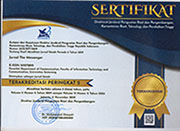Digital Gender Gap for Housewives
Abstract
Keywords
Full Text:
PDFReferences
Ahrens, J. (2009). Going Online, Doing Gender: Everyday Practices Around the Internet in Germany and Australia. Germany: Bielefeld.
Bourdieu, P. (1991). The Political Ontology of Martin Heidegger. Stanford: Stanford University Press.
Lestari, A.P. (2017). Penonton Anak dan Remaja Terkait Program Acara Indonesian Idol Junior 2016: Studi Resepsi Pada Kontestan Anak yang Menyanyikan Lagu-lagu Orang Dewasa. Jurnal The Messenger, 9 (1), 55-64.
Hardiman. (2009). Kritik Ideologi: Menyingkap Pertautan Pengetahuan dan Kepentingan Bersama Jurgen Habermas. Yogyakarta: Kanisius.
Moustakas, C. (1994). Phenomenological Research Methods. Thousands Oaks: Sage Publications.
Merleau-Ponty, M. (2001). Humanism and Terror. Boston: Beacon Press.
Kennedy, T.L.M. (2006). Gender and the Household Internet, Encyclopedia of Gender and Information Technology. IGI Global.
Setiawan, Y.B., Fanani, F., Julianto, E.N. (2013). Bias Gender Dalam Cerita Rakyat: Analisis Naratif pada folklore Eropa, Cinderella, dengan Cerita Rakyat Indonesia, Bawang Merah Bawang Putih. Jurnal The Messenger, 5 (2), 1-13.
Sunarto. (2007). Kekerasan Televisi Terhadap Wanita: Studi Strukturasi Gender Industri Televisi dalam Naturalisasi Kekerasan terhadap Wanita Melalui Program Televisi untuk Anak-anak di Indonesia. Disertasi: Universitas Indonesia.
Sunarto. (2009). Televisi, Kekerasan, dan Perempuan. Jakarta: Kompas.
Tong, R.P. (2008). Feminis Thought: Pengantar Paling Komprehensif Kepada Aliran Utama Pemikiran Feminis (Terj.). Yogyakarta: Jalasutra.
Littlejohn, S.W., Foss, K.A. (2008). Theories of Human Communication (9th Edition). USA: Thompson Wadsworth.
Wacjman, J. (2007). From Women and Technology to Gendered Technoscience. Information Communication and Society, 10 (3). Routledge, Taylor and Francis.
DOI: http://dx.doi.org/10.26623/themessenger.v10i1.729
Refbacks
- There are currently no refbacks.
Copyright (c) 2018 Jurnal The Messenger
View My Stats [Jurnal The Messenger] is an International Scientific Journal, Published by the Department of Communication, Faculty of Information Technology and Communication, Universitas Semarang (Central Java, Indonesia). It is licensed under a Creative Commons Attribution 4.0 International License.



_11.jpg)




_BARCODE.jpg)
_BARCODE1.jpg)


5.png)










2.png)





